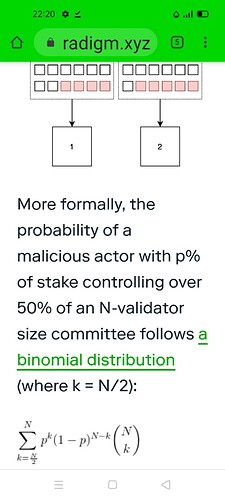Regarding the article
I have some doubts about the formula in here
-First of all, the formula presented is missing a parameter say “M” to represent the number of groups ( committees we have), where the probability P of myopic represents having say “X” malicious such that
P=X/NM
So there must be something wrong in this formula
-True at the end the shuffling algorithm chooses one at random, this could mean to divide the resulting probability by 1/M, but not to execlude M at all; I don’t think things are that simple.
-Bernoulli trials ( which the binomial distribution is based on) only have two outcomes ( like throwing a coin), but we here have more than 2 groups; it looks like the number of slots was mixed up with the number of groups or maybe the simple example above it.
-It could be more viewed like throwing a dice only with M outcomes (I mean throwing a dice is a special case or example with M=6)
»»»I think there maybe(probably) a known formula or distribution for such probability that I can’t recall now
.
-Another way of viewing it is like u have an NM bits number where u know have exactly X=PN*M 1s (or 0s), we want to know the probability that when partitioning the number to groups of N contiguous bits, at least N/2 of the X 1s will be in one of those groups.
Till we are able to derive a general formula ( or someone remind us of known one from the literature), please follow this simple examples with me to realize the error in the equation when we have more than 2 groups; ie. M≥3
.
-Let M=3, N=5 (15 attestor divided into 3 groups of 5 each)
-say X=4 ( we have 4 malicious/myopic persons) where 0.25≤(P=4/15)≤0.33
P~=0.2666..
.
The 4 malicious (consider them persons, ie identity matters let’s call them A,B,C,D)
Have 3⁴=81 ways to be distributed over the 3 groups (each has 3 choices to one of the groups, and in general these choices are indep as long as N≥X)
-Possible outcomes are:
4,0,0 ==⟩ can happen in 3 ways
(which of the 3 groups they will be in)
3,1,0 ==⟩ can happen in 432=24 ways:
Pick each of the 4 be the single one and choose its group in 3 different ways, the remaining have 2 choices of the 2 remaining groups; in detail
ABC,D,0/ABC,0,D/0,ABC,D/0,D,ABC/D,ABC,0/
D,0,ABC
Then repeat for
ABD,C,0
BCD,A,0
ACD,B,0
.
Till now prob =(3+24)/81=27/81=1/3
That’s larger than initial probability (if we re-divide by3 for the shuffler selection we get 1/9 still not the same as the presented formula).
We can check the rest of options (less than 50% of N) to be sure the enumeration of all cases add up to 81 so we are not wrong.
.
-2,2,0 ==⟩3*6=18
-Divide them into 2 groups in 3 ways?
AB,CD/AC,BD/AD,BC
that’s it
-now arrange the 3 partitions (these two& zero)in the 3 groups in 3!=6 ways
2,1,1==⟩ 66 =36
1st two& their group in 123/2=6ways
The arrangement in the groups in 3!=6 ways
AB,C,D/AB,D,C/C,AB,D/C,D,AB/D,AB,C/D,C,AB
AC,B,D/AC,D,B
AD,B,C/AD,C,B
BC,A,D/BC,D,A
BD,A,C/BD,C,A
CD,A,B/CD,B,A
.
Total=3+24+18+36
=81 ✓
If u find this example hard to follow check the case when X=3 (P=3/15=0.2)
.
A,B,C
A(1,2,3),B(1,2,3),C(1,2,3) 27 ways
3,0,0 ⟩ 3 ways
Prob(≥50%)=3/27=1/9
check the rest:
2,1,0 ⟩ 332=18ways
1,1,1⟩ordering=3!=6ways
total=3+6+18=27 ✓
If u get it now, check the case where P=1/3, ie X=5 like N, we have the possibilities:
5,0,0 ==⟩ could happen in 3 ways
4,1,0 ==⟩ 30
5 ways to choose the single one* 3!=6 to arrange
3,2,0 ==⟩60
54/2=10 to choose 3 out of 5, then * 3!=6 to arrange
3,1,1 ==⟩60
54/2=10 to choose 3 out of 5, then * 3!=6 to arrange
2,2,1 ==⟩90
5 to choose the single one, * selecting 2of4 43/2=6, /2 divided by 2 for the order of the 2 elements partitions doesn’t count, 3!=6; ie 566/2=90
Total no of ways =3⁵=243
Prob(≥50%)= (3+30+60+60)/243 =153/243 =51/81 … ≥ 0.5
If we divide by 3 again for the o/p of the shuffling is only 1 committee
51/243=0.209
Now let’s get back to the formula in the article & substitute with N=5 for both values of P to see the difference in the results:
When X=3, p=0.2
the summation has only one term
Prob=(0.2)³ (0.8)²10
=864/10⁴= 0.0512
»»»» Does NOT equal 1/9
If we tried to divide by 1/3 (maybe this is his point)
1/27~0.037037…
still NOT the same
.
When X=4, P=4/15, 1-P=11/15
The summation has 2 terms 4,1 and 3,2
Prob= (4/15)⁴(11/15)5 + (4/15)³(11/15)²*(54/2)
=(4³/15⁵)115[4+112]
=(641126)/(3*15⁴)
=18,304/151,875
=0.12052
»»»» Does NOT equal 1/3
If we tried to divide by 1/3 (maybe this is his point)
1/9~0.11111…
still NOT the same
When X=5, P=1/3, 1-P=2/3
The summation has 3 terms 5,0 & 4,1 & 3,2
Prob= (1/3)⁵ + (1/3)⁴(2/3)5 + (1/3)³(2/3)²*(54/2)
=(1/3)⁵ [1+ 25 + 410]
=51/243
Only in this case when X=N, the probability is the same as after selecting a group at random, but this is a special case; and yet the probability is not very small though
.
I know I didn’t derive a fixed formula or recall an existing one from the literature yet, but at least this to point out the written one is not accurate?
